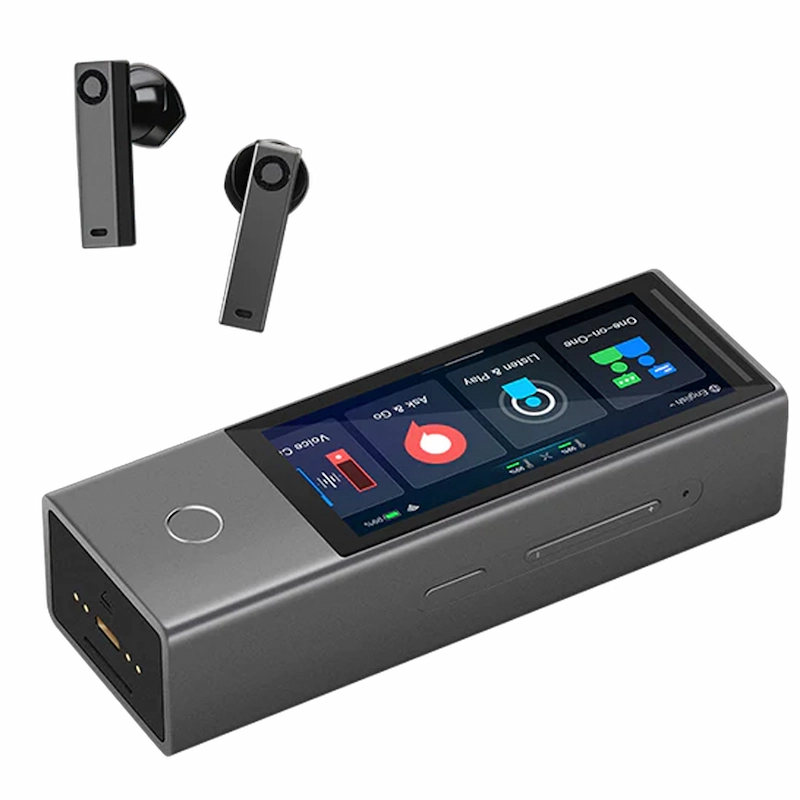
Translation accuracy
95%
Warranty
12 months
Updates
Yes
No. of languages
40
No. of translation engines
1
Customer service in English
User manual in English
Device menu in English
SIM card included
Free internet period
Not applicable
Price for renewing Internet data package
Not applicable
No. of countries where SIM card works
Not applicable
Translation sharing option
Weight (ounces)
570 g
Color options available
grey
Price
$699.99
Country of manufacturer
China
2
Place
Rating
8.5/10
Independent operation without the need to connect to a mobile device
13 offline language pairs, but mainly with Chinese
Ability to create a translation network, but only for X1 hubs
High price, need to purchase additional hubs for full functionality
Unhygienic in-ear design (especially problematic when sharing)
Heavy construction (570 g)
Timekettle X1 is an electronic translator consisting of a hub and wireless earbuds. The device supports 40 languages online and 13 language pairs in offline mode, but mainly pairs with Chinese. Features like Listen & Play or Ask & Go are big advantages. A significant drawback is the high price of the device (about $700), especially given the need for additional expenses on offline languages ($12.50 per pair) and purchasing additional hubs for full functionality. The weight of the device (570 g) and the lack of a built-in SIM card are further drawbacks, although the option to insert your own SIM is definitely an advantage.
After taking the Timekettle X1 out of the box, we immediately noticed its considerable weight - 570 g is really heavy for a device that’s meant to be mobile. The hub has a solid construction, but the slide-out earbud compartment raised our concerns about durability - the mechanism seems like it might stop closing properly over time. The initial configuration proved to be quite lengthy and not very intuitive. Also, the Timekettle app offers tutorials in only four foreign languages (English, Spanish, Chinese, and Japanese), which may be a big obstacle for some users. However, it’s worth emphasizing that once you get through the configuration, the device works very smoothly and intuitively.
During our tests, we checked all available operating modes:
Listen & Play Mode– this is definitely a stronger point of the X1. During a business meeting, it was enough to place the device on the table to receive translation directly into the earbuds. The translation quality was good, although there were slight delays with faster speech.
Ask & Go Mode – also performed well. Holding down the button and saying a phrase in one language resulted in quick translation and playback through the speaker.
One-on-One (1:1) Mode – enables face-to-face conversation with someone speaking another language, where each person uses one earbud. Here we encountered the first serious problem - the in-ear earbuds raised hygiene concerns when sharing with strangers. The included four plastic covers are definitely not enough for intensive use, and putting them on, taking them off, and cleaning them was cumbersome. The two attachments meant to prevent the earbuds from falling out of the ears turned out to be small, difficult to fit, and did not improve comfort.
Multi-Person Mode – we tested with three devices (we didn’t have more available) and it did enable multilingual communication. However, the main problem is that only the administrator’s microphone is active, which requires additional configuration for seamless conversation. Moreover, each participant must have their own X1 device, which at $700 per piece makes it simply too expensive for most applications.
Voice Call Mode – allows for remote conversations, but only between X1 owners. This is a significant limitation because it’s unlikely that the person you want to contact would have an identical device.
We must admit that the online translation quality was high - the claimed 95% accuracy seems close to the truth, although with longer statements there were noticeable delays. Despite the manufacturer advertising the device as equipped with AI semantic segmentation technology, which was supposed to prevent this, in practice it worked with average effectiveness. The noise reduction technology eliminates background noise and allowed for the use of the translator during business meetings, which we simulated in a crowded café. However, it works better in a quieter environment.
The device offers 40 languages online and 13 language pairs offline. In practice, however, we discovered that most offline pairs are combinations with Chinese or English as the base language, which significantly limits usefulness for users who are not fluent in these languages. Moreover, offline functions only work in 1:1 and Listen & Play modes. The lack of a built-in SIM card forces reliance on Wi-Fi, which significantly limited the mobility of the device – especially during our tests abroad, when network access was difficult or expensive.
Timekettle X1 is undoubtedly a device with great potential. Unfortunately, the prohibitive price ($700), the necessity to rely on Wi-Fi (unless you add your own SIM card - a plus for adding such an option) and the need to purchase multiple devices for group features make it cost-ineffective for an average user. There are also problems with translation delays, and earbud ergonomics. Although the Listen & Play and Ask & Go functionalities work well, they don’t balance out the fundamental limitations of the product. Who is it for? For businesses, travelers who have lots of money, and language enthusiasts. Who isn’t it for? For those who want it to be quick and cheap.
Copyright © 2025 voice-translator-review.com